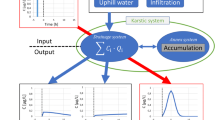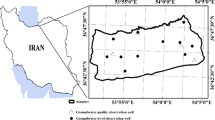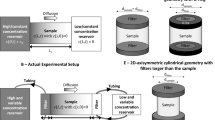Abstract
An iterative inverse method, the sequential self-calibration method, is developed for mapping spatial distribution of a hydraulic conductivity field by conditioning on nonreactive tracer breakthrough curves. A streamline-based, semi-analytical simulator is adopted to simulate solute transport in a heterogeneous aquifer. The simulation is used as the forward modeling step. In this study, the hydraulic conductivity is assumed to be a deterministic or random variable. Within the framework of the streamline-based simulator, the efficient semi-analytical method is used to calculate sensitivity coefficients of the solute concentration with respect to the hydraulic conductivity variation. The calculated sensitivities account for spatial correlations between the solute concentration and parameters. The performance of the inverse method is assessed by two synthetic tracer tests conducted in an aquifer with a distinct spatial pattern of heterogeneity. The study results indicate that the developed iterative inverse method is able to identify and reproduce the large-scale heterogeneity pattern of the aquifer given appropriate observation wells in these synthetic cases.
Similar content being viewed by others
References
Capilla J, Gómez-Henández J, Sahuquillo A (1997) Stochastic simulation of transmissivity fields conditional to both transmissivity and piezometric data, 2. Demonstration on a synthetic aquifer. J Hydrol 203(1–4):175–188
Capilla J, Gómez-Henández J, Sahuquillo A (1998) Stochastic simulation of transmissivity fields conditional to both transmissivity and piezometric data, 3. Application to the Culebra formation at the Waste Isolation Pilot Plant (WIPP), New Mexico, USA. J Hydrol 207(3–4):254–269
Carrera J, Medina A, Galarza G (1993) Groundwater inverse problem: Discussion on geostatistical formulations and validation. Hydrogeologie 4:313–324
Dagan G (1985) Stochastic modeling of groundwater flow by unconditional and conditional probabilities: The inverse problem. Water Resour Res 21(1):65–72
Datta-Gupta A, King MJ (1995) A semianalytical approach to tracer flow modeling in heterogeneous permeable media. Adv Water Resour 18(1):9–24
Datta-Gupta A, Vasco DW, Long JCS, Vomvoris S (1994) Stochastic modeling of spatial heterogeneities conditioned to hydraulic and tracer tests. In: Proceedings of the 5th annual international conference on high level radioactive waste management, vol 4. Am Soc Civ Eng, Reston, pp 2624–2632
Datta-Gupta A, Lake LW, Pope GA (1995) Characterizing heterogeneous permeable media with spatial statistics and tracer data using sequential simulation annealing. Math Geol 27(6):763–787
Datta-Gupta A, Vasco DW, Long JCS (1997) On the sensitivity and spatial resolution of transient pressure and tracer data for heterogeneity characterization. SPE Form Eval 12(2):137–144
Deutsch CV, Journel AG (1998) GSLIB geostatistical software library and user’s guide, 2nd edn. Oxford University Press, Oxford, p 340
Gómez-Hernández JJ, Sahuquillo A, Capilla JE (1997) Stochastic simulation of transmissivity fields conditional to both transmissivity and piezometric data, 1. The theory. J Hydrol 203(1–4):162–174
Gutjahr AL (1989) Fast Fourier transforms for random field generations. Report No 196, New Mexico Institute of Mining and Technology, Socorro, NM
Harvey CF, Gorelick SM (1995) Mapping hydraulic conductivity: Sequential conditioning with measurements of solute arrival time, hydraulic head, and local conductivity. Water Resour Res 31:1615–1626
Hoeksema RJ, Kitanidis PK (1984) An application of the geostatistical approach to the inverse problem in two-dimensional groundwater modeling. Water Resour Res 20(7):1003–1020
Kitanidis PK, Vomvoris EG (1983) A geostatistical approach to the inverse problem in groundwater modeling (steady state) and one-dimensional simulations. Water Resour Res 19(3):677–690
Li B, Yeh T-CJ (1999) Cokringing estimation of the conductivity field under variably saturated flow conditions. Water Resour Res 35:3663–3674
McLaughlin D, Townley LR (1996) A reassessment of the groundwater inverse problem. Water Resour Res 32(5):1131–1162
Rubin Y, Dagan G (1987) Stochastic identification of transmissivity and effective recharge in steady groundwater flow, 1, Theory. Water Resour Res 23(7):1185–1192
Rubin Y, Dagan G (1992) Conditional estimation of solute travel time in heterogeneous formations: Impact of transmissivity measurements. Water Resour Res 28(4):1033–1040
Sun N-Z (1994) Inverse problem in groundwater modeling. Kluwer Academic, Norwell, p 337
Wen X-H, Gómez-Henández J, Capilla JE, Sahuquillo A (1996) Significance of conditioning to piezometric head data for predictions of mass transport in groundwater modeling. Math Geol 28(7):951–968
Wen X-H, Capilla JE, Deutsch CV, Gómez-Henández J, Cullick AS (1999) A program to create permeability fields that honor single-phase flow rate and pressure data. Comput Geosci 25:217–230, 1131
Wen XH, Deutsch CV, Cullick AS (2002) Construction of geostatistical aquifer models integrating dynamic flow and tracer data using inverse technique. J Hydrol 255:151–168
Yeh T-CJ, Zhang J (1996) A geostatistical inverse method for variably saturated flow in the vadose zone. Water Resour Res 32:2757–2766
Yeh WWG (1986) Review of parameter identification procedures in groundwater hydrology: The inverse problem. Water Resour Res 22:95–108
Zhang J, Yeh T-CJ (1997) An iterative geostatistical inverse method for steady flow in the vadose zone. Water Resour Res 33:63–71
Zimmerman DA, de Marsily G, Gotway CA, Marrietta MG, Axness CL, Beauheim RL, Bras RL, Carrera J, Dagan G, Davies PB, Gallegos DP, Galli A, Gómez-Hernádez J, Grindrod P, Gutjahr AL, Kitanidis PK, Lavenue AM, McLaughlin D, Neuman SP, RamaRao BS, Ravenne C, Rubin Y (1998) A comparison of seven geostatistically based inverse approaches to estimate transmissivities for modeling advective transport by groundwater flow. Water Resour Res 34(6):1373–1413
Author information
Authors and Affiliations
Corresponding author
Rights and permissions
About this article
Cite this article
Hu, B.X., He, C. Using Sequential Self-Calibration Method to Identify Conductivity Distribution: Conditioning on Tracer Test data. Math Geosci 40, 845–859 (2008). https://doi.org/10.1007/s11004-008-9160-x
Received:
Accepted:
Published:
Issue Date:
DOI: https://doi.org/10.1007/s11004-008-9160-x




